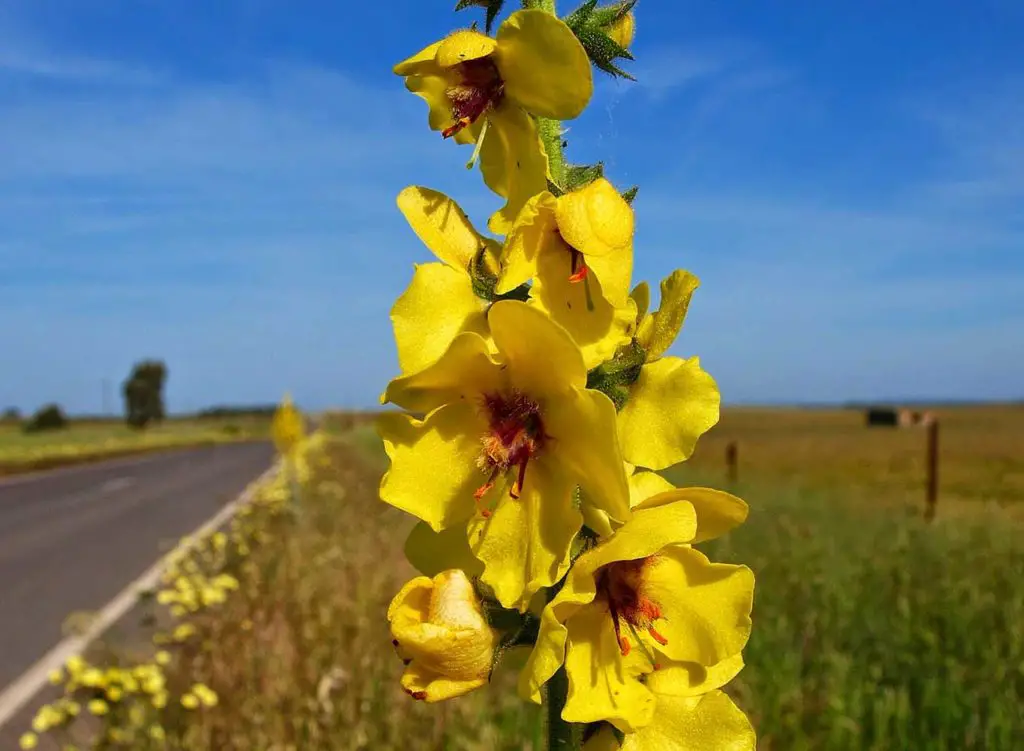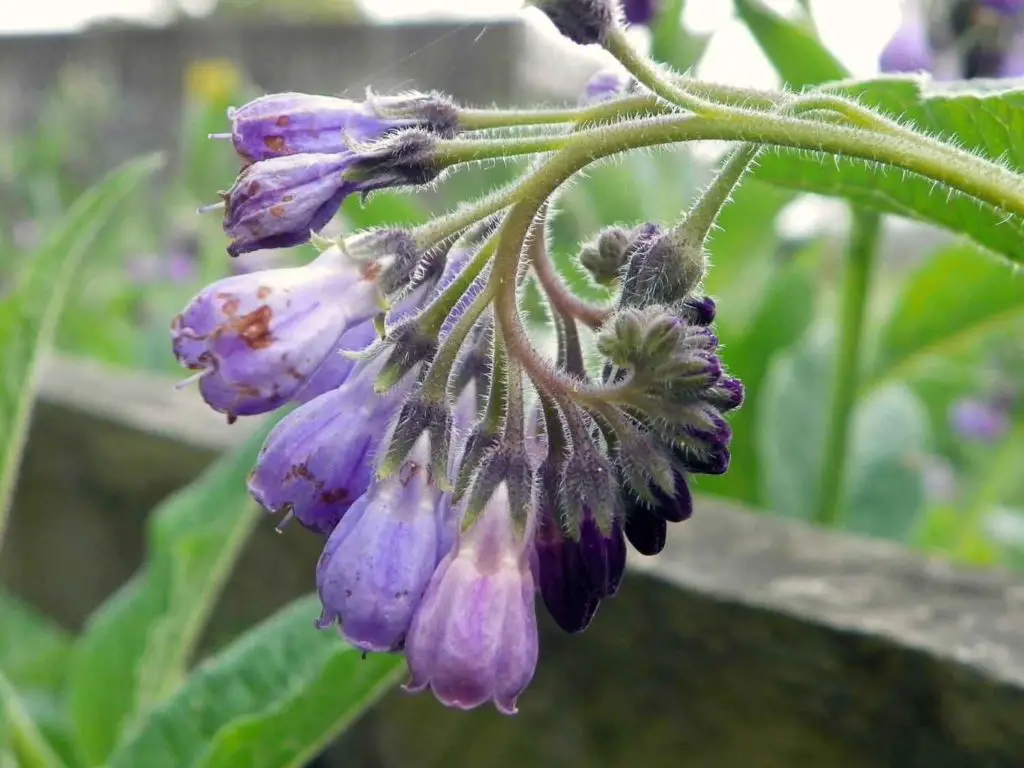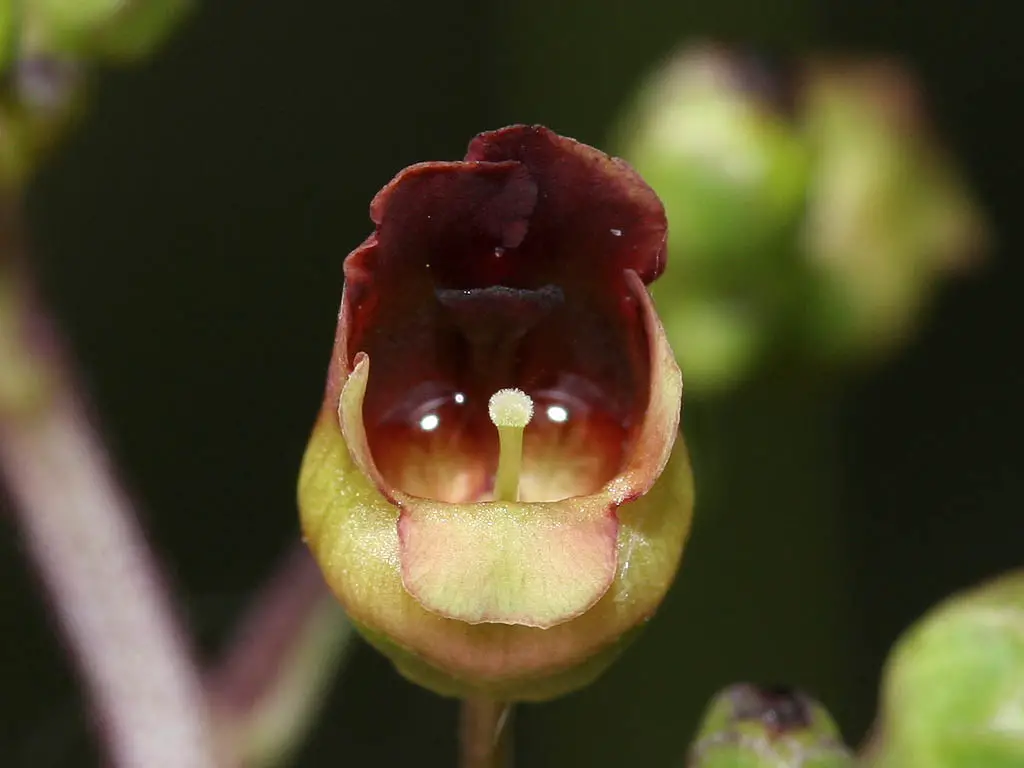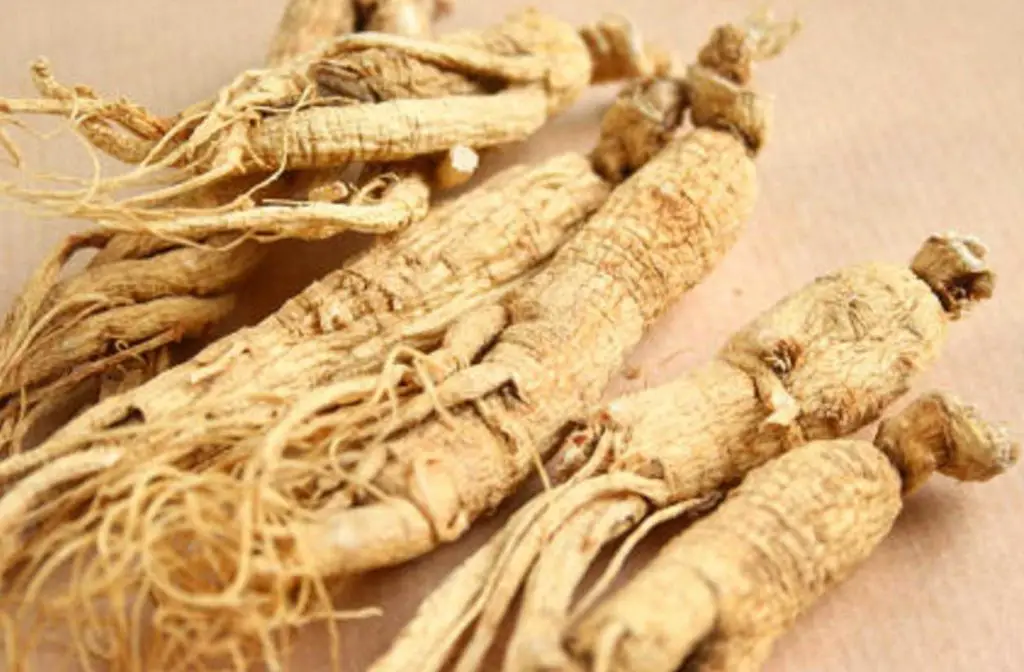What is Mullein?
Mullein, also known as velvet plant, candlewick plant, rag paper, blanket leaf, Aaron’s rod, Bullock’s Lungwort, Jacob’s staff, and old man’s flannel, typically refers to the species Verbascum thapsus. Mullein is part of the Scrophulariaceae family. Commonly researched as the Great Mullein, Mullein is native to Europe, Africa, and Asia. In Spain, it can also be referred to as Gordolobo (not to be confused with the Mexican Gordolobo referring to Gnaphalium Obtusiflolium).
The leaves, roots, and flower of Mullein has long been used for respiratory health and wound healing. Young plants grow large, hairy leaves in a rosette-shaped pattern, and in its second year of growth, the plant grows a pole-like spike that will later flower. That spike can range from 1-8 feet in height. Once the plant develops flowers, they are densely packed on the spike. The flowers are usually yellow and close to an inch in diameter. Typically, it is the flower “branches” that are sold as medicinal herbs. A tea made from the flowers is said to have a bitter taste, but it may be improved with other flavors like lemon, mint, or honey.

Traditionally, Mullein has been used to treat skin afflictions, like rashes or dermatitis, but it may also be used to treat respiratory conditions, urinary issues, and bacterial and viral infections. Its use as a medicine can be traced back for centuries in Latin American countries, and in Europe the tradition dates back to the Ancient Greeks. More recently, research suggests that there may be global use and applications for human health and wellness. However, research on this plant is still very preliminary and largely consists of in vitro studies.
Great Mullein Benefits, and Uses
Cough
Traditionally, Mullein has been used to treat a myriad of conditions associated with coughs like bronchitis, whooping cough, tuberculosis, asthma, and hoarseness. This use still needs to be evaluated in a scientific manner, but many have made suggestions as to why is may be so effective for treating coughs. First, the leaves may have the ability to reduce inflammation, which in turn reduces throat irritation and coughing. Second, it increases the amount of sputum (i.e. mucus) produced by the lungs which soothes the respiratory system when inflamed. Whatever the reason may be for its effectiveness, many anecdotes support its use for this purpose. Additionally, a 2002 study showed that Mullein can prevent the spread of Klebsiella pneumonia (see antibacterial section below), a species of bacteria associated with pneumonia and coughing
Asthma
Considering its popular use to treat coughs and other lung conditions, it should be of no surprise that Mullein has also been used to help those suffering with asthma. This condition still requires research, but considering that Mullein is known to reduce inflammation and promote relief, it is likely that those benefits have something to do with its use as an asthma treatment. Despite the lack of research, Mullein formulas designed to help with asthma and other pulmonary afflictions have high ratings and many success stories.

Ear Pain
Presently, there is only one reported human clinal use of Mullein from a study in 2001, and it was to treat otitis media, a condition characterized by inflammatory diseases of the middle ear. In that study, children were given a treatment containing mullein and other soothing medicinal herbs like garlic, calendula, and St. John’s wort. That formula was applied to the ear over a period of three days, and after that period, the pain associated with ear infection subsided. Not only did this study evaluate the effectiveness of the Mullein formula in treating ear pain, but also showed that it is safe for external use in children. Some also suggest that Mullein can prevent ear infections in dogs as well, showing that it is also safe and effective for pets.
Antibacterial
An in vitro study conducted in 2002 showed that Mullein has the ability to kill many different bacteria. In that study, extracts were taken from the common mullein (Verbascum thapsus) and prepared in water, methanol, and ethanol. The extracts were particularly effective in the water preparation in reducing the bacteria Klebsiella pneumonia, Staphylococcus aureus, Staphylococcus epidermidis and Escherichia coli. In 2011, another study was conducted that tested the effects of essential oil taken from the plant on other microbes. Higher doses of the treatment showed to have an inhibitory effect on Bacillus subtilis, Staphylococcus aureus, Salmonella typhi, Pseudomonas aeruginosa and Aspergilus niger. However, it did not seem to have any effect on Escherichia coli and the fungus Candida albicans.
Urinary Tract Infections
A popular traditional use of Mullein is to treat urinary conditions, and it is thought to work by reducing inflammation and soothing the urinary tract. While research is limited in this area, the 2002 study that demonstrated that the plant may have antibacterial properties (see section above) may have applications for this treatment. While more studies on other species of bacteria need to be conducted, it is very possible that Mullein can prevent and treat bacterial infections associated with UTIs.
Parasites
Tribal communities have used Mullein for centuries to treat parasitic infections, but those effects were not evaluated scientifically until 2012. In that study, crude aqueous methanolic extracts of Verbascum thapsus were tested against roundworms and tapeworms. Once the extracts were applied to the worms, both species experienced paralysis when the extract was used at high doses. This study supports its traditional and suggests work be conducted to advance research on mulleins and anti-parasitic treatments.
Flu
A study conducted in 2009 tested the effects of several traditional treatments on the influenza virus to determine how many were actually effective in treating or preventing the virus. In this in vitro study, isolated cells of the virus were exposed to 41 different plant extracts. Of all those plants, Verbascum thapsus along with 6 other species were shown to have very high anti-viral activity against influenza. Based on those results, it is also very possible that Mullein may be effective in treating other viruses, but more research still needs to be conducted.
Wounds
Mullein is frequently used to treat the skin, but also has a promising effect on wound healing. A study conducted in 2011 tested the effects of a Verbascum thapsus treatment, a zinc treatment, a Eucerin treatment, and a control treatment on surgically induced wounds in rabbits. Compared to the control group that only received a standard topical ointment, the group of rabbits that received the Verbascum treatment showed a statistical improvement over the control group and Eucerin treatment. However, it was not as effective as the zinc-based treatment.
Staph Infections
Studies conducted in in 2002 and 2011 (see antibacterial section above) show that Mullein has an inhibitory effect on Staphylococcus aureus and Staphylococcus epidermidis. S. aureus is often associated with the difficult-to-treat staph infection called MRSA and are also associated with skin infections and eczema. S. epidermis is commonly associated with acne and does not always respond to antibiotics. As staph infections become more common and less affected by antibiotics, Mullein may prove to be an effective treatment against the disease. However, much more research is needed in this area before it will be considered as an official treatment. Warning: Staph can be potentially deadly, seek your doctors advice.

Mullein Dosage
Different conditions require different dosages and preparations.
For external use, two branches should be boiled in 1 liter of water to make a tea. The same preparation can be used for sore throats; gargle with the tea over the course of a day to treat a sore throat. Ear infections may be treated with 1-2 drops of this tea at a time.
Some conditions (e.g. lung and urinary conditions) require that the tea be ingested. If ingesting Mullein, boil 1½ cups of water with 2 tablespoons of dried herb. Other soothing herbs, like mint, may also be added to the recipe.
Mullein Side Effects, Safety, Dangers and Warnings
Toxicity has not been thoroughly investigated for this herb, so it is best to avoid use if you are pregnant or breastfeeding. Other species of mullein have seeds that are toxic, so use caution and purchase from a reputable source. Many foreign sources are known to replace real Mullein with similar looking, dried flowers.
Mullein should not be used on babies, because it can cause serious urinary conditions and harm other bodily functions. However, extracts from the plant have been used to treat external conditions on children.
Avoid use if you are allergic to plants within the Daisy family. There has been one report of contact dermatitis from handling Mullein.
If not strained properly, a tea made from Mullein may cause throat irritation.
People with known liver conditions, like hepatitis or jaundice, should not consume Mullein because it is high in coumarins, which can agitate the liver.
Do not use for ear infections if you have a perforated ear drum and consult a physician if symptoms pf ear pain or infection do not subside quickly.
Drug interactions have not been fully evaluated for Mullein yet, but some suggest that Mullein may reduce the effectiveness of antidiabetic drugs and intensify the effects of muscle relaxers. Consult with a doctor if you are taking prescription medications before using Mullein.

References:
https://www.ncbi.nlm.nih.gov/pmc/articles/PMC2952292/
https://www.ncbi.nlm.nih.gov/pubmed/26642647
https://www.ncbi.nlm.nih.gov/pubmed/21999656
https://linkinghub.elsevier.com/retrieve/pii/S0378874102001861
https://onlinelibrary.wiley.com/doi/abs/10.1002/ptr.1653
https://www.ncbi.nlm.nih.gov/pmc/articles/PMC3350428/
https://www.ncbi.nlm.nih.gov/pubmed/22463730
https://www.ncbi.nlm.nih.gov/books/NBK92033/
https://www.ncbi.nlm.nih.gov/pmc/articles/PMC2322858/





Is it known whether the wildflower/ weed commonly called Moth Mullein is also valuable as an herb with similar properties to the great mullein?
Mullein is one of the best herbs to fight with cough, thank you for this interesting post about it! I had a very long recovery with annoying cough and awful exhaustion, I was tired all the time because of that. Mullein leaf drops https://amzn.to/4lKKLIK helped me to fight my cough, but it took more than a month to recover fully and to come back to normal life..
Mullein is very helpful for lungs, and it is a natural remedy that almost never has side effects. I always add a few drops of my mullein extract for lung detox into my daily beverage when I start coughing, I think it would have even better effect! These lung drops are great when I have cough or flu, and also herbal tea with lemon provide me a necessary dosage of vitamins and quick relief thanks to anti-inflammation effect.